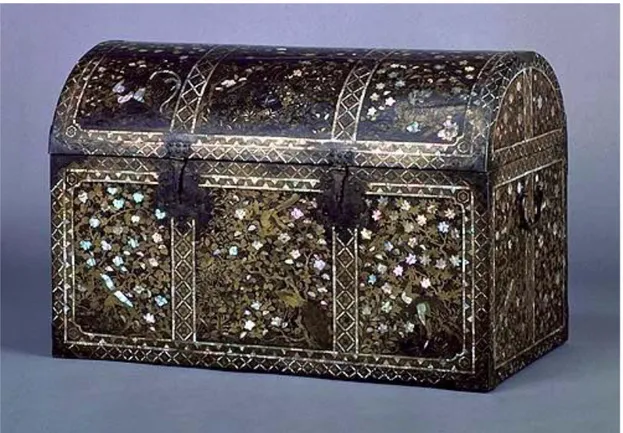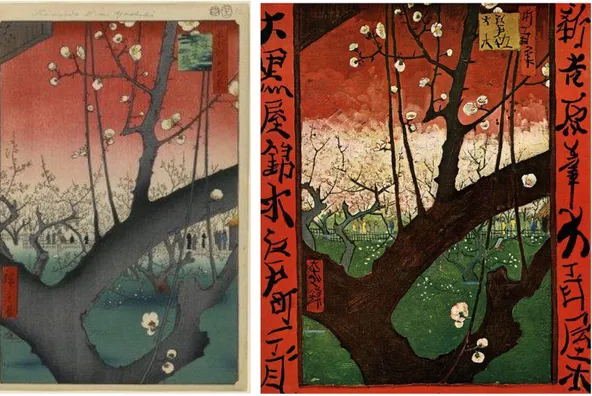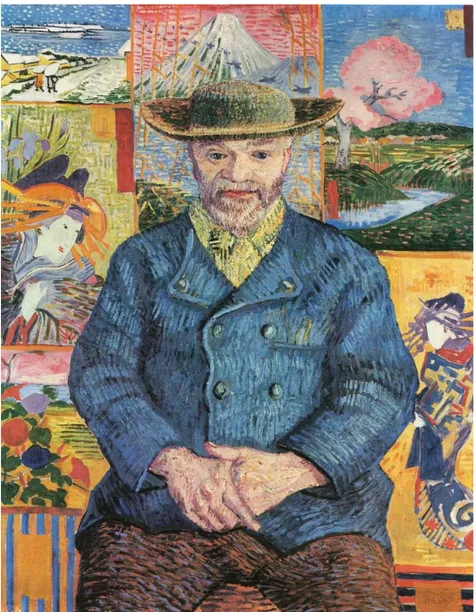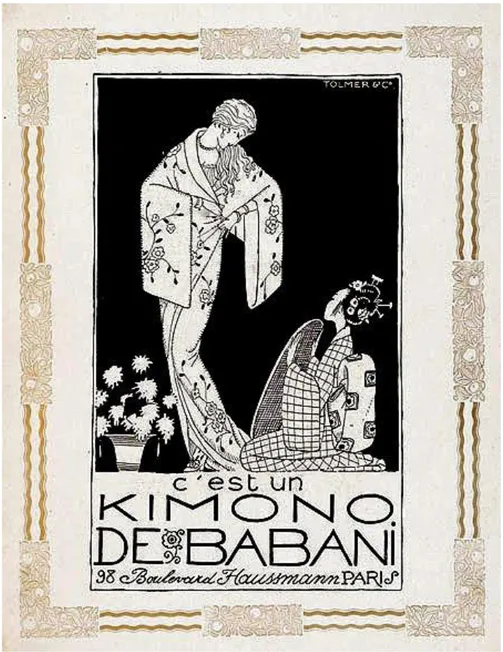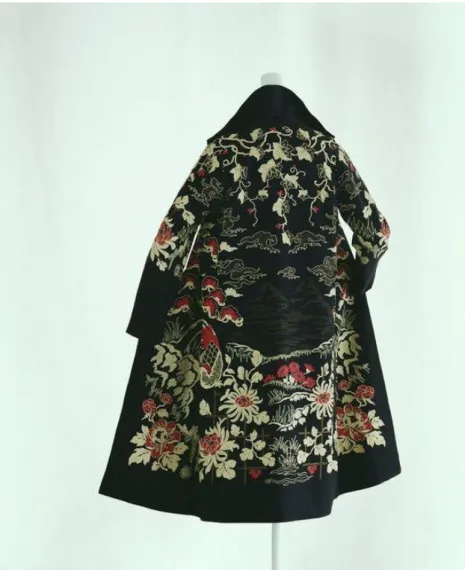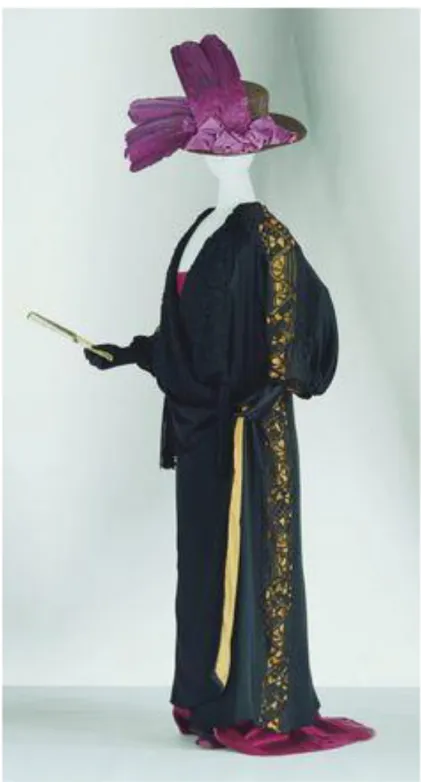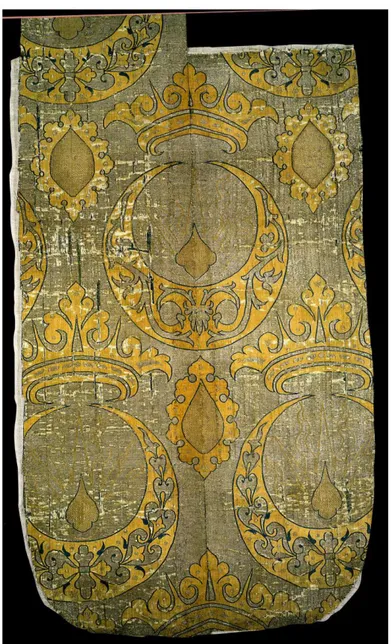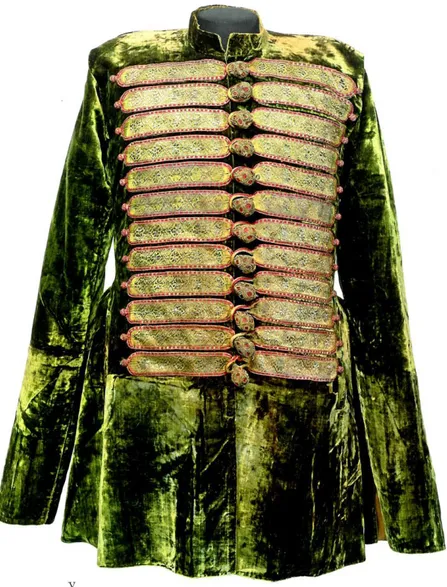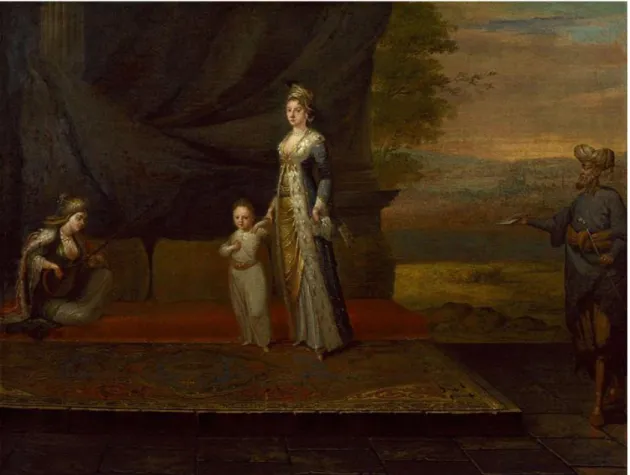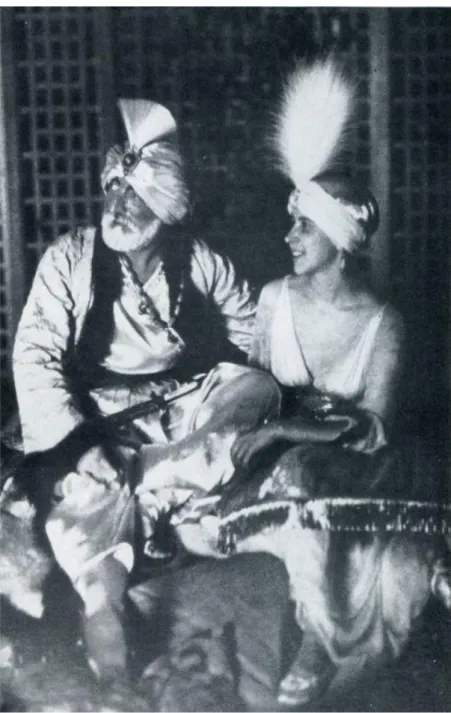INTERACTION BETWEEN EAST AND WEST CONCERNING VISUAL CULTURE AND FASHION: FOCUS ON JAPAN AND TURKEY
Fumika Ochi 114611021
Istanbul Bilgi University Social Science Institution Cultural Studies Master Program
Asst. Prof. Dr. Gülsen Bal Istanbul
TABLE OF CONTENTS
Abstract………1 Introduction
1.1 History of Westernization in Japan and Turkey ··· 7 1.2 Influence of Westernization Movement on Female Identity in Japan and Turkey · 37 2. Visual Interactions between East and West: Eastern influence on Western culture Japan
2.1 Prehistory of Japonism, discovery of Eastern art of work evokes an exotic curiosity among Westerners in the Renaissance period ··· 63 2.2 Eastern art and fashion has appeared as target of art appreciation in Western
countries ··· 66 2.3 European artists and upper-class had adopted Eastern visual art and they inspire to innovate new trend ··· 68 2.4 Eastern fashion imparts a variation of Western fashion and contribute to
emancipation of women from corset ··· 73 Turkey
2.5 Prehistory of Turquerie, discovery of Eastern art of work evokes an exotic curiosity among Westerners in the Renaissance period ··· 82 2.6 Eastern art and fashion appeared as target of art appreciation in western countries93 2.7 European artists and upper-class had adopted Eastern visual art and they inspire to innovate new trend ··· 95 2.8 Eastern fashion imparts a variation of western fashion and contribute to
emancipation of women from corset ··· 102 3. Visual Interactions between East and West: Western influence on Eastern culture Japan
3.1 Adaptation of Western costume by military, bureaucrats and upper-class ··· 107 3.2 Birth of eclectic fashion of Western and traditional costume ··· 110 3.3 Emergence of Garçonne, flapper style accelerates westernization in fashion ···· 120 3.4 Westernization reach to transform Eastern aesthetic ··· 123 Turkey
3.5 Adaptation of Western costume by military, bureaucrats and upper-class ··· 134 3.6 Birth of eclectic fashion of Western and traditional costume ··· 136 3.7 Emergence of Garçonne, flapper style accelerates westernization in fashion ···· 146 3.8 Westernization reach to transform Eastern aesthetic ··· 158 4.Conclusions ··· 163
5.List of illustration ··· 168 6.Bibliography ··· 170
1
Abstract
Culture is the element that constantly changes and interacts. One of the areas that intense interaction can be seen is visual art and fashion. Georg Simmel describes fashion as a desire to change, and emulation.1 The inspirations from different cultures play an important part in the emergence of the “new” concept in fashion.
After the Industrial Revolution, the Western culture has been influential on the East. However, it is also possible to see the influence of the Eastern culture on the West. So, how have the West and the East been inspired and benefited from each other to enrich their art and culture?
In this thesis, interactions between East and West are examined. I especially focused on the interactions concerning visual arts, fashion, and beauty concepts since intense
interaction is seen in those areas.
First of all, I examined the general westernization process of Eastern countries, and bring the general character of westernization processes into sharp contrast. I select Japan and Turkey as representatives of Eastern countries that have been affected by the West, since these two countries have modernized quickly after establishing their own civilization. Meiji Japan and the early Republic period of Turkey took advantage of nationalism as a means of
2
establishing modern nation-state. In this process, their female identity also had transformed drastically. Thus, influence of westernization movement on female identity in Japan and Turkey is also examined.
In terms of visual art and cultural aspects, the West and the East have interacted intensely. The East helped to change Western common sense with its exotic elements. Especially, arts such as ukiyo-e in Japan, and Ottoman textile have gathered attention and inspired the Western artists. The interest of the West toward the Orient extends to fashion.
Kimono in Japan and şalvar in Turkey had been seen as a quite novel design on the
Westerners’ eyes; and those designs inspired Western designers to create unconventional, yet practical clothes.
On the other hand, when it comes to the influence of the West on the Eastern culture, it was not limited to the change of the political system and the rise of women’s rights. It has also been a big influence in terms of visual culture and fashion. Comfortable and practical clothes inspired by the Orient have been developed and popularized by designers such as Paul Poiret, and have been introduced in magazines, and consumed by Japanese and Turkish upper-class. Many of them adopted eclectic fashion, which is composed of indigenous and Western fashion, since tradition persisted. Gradually, Eastern beauty sense also has been westernized, and many of the young generation pursued the ideal European look.
3
As a result, the traditional East and the innovative West have inspired each other and undergone drastic changes affecting one another. And those changes went beyond imitating each other.
4
Özet
Kültür sürekli değişen ve birbirini etkileyen unsurdur. Etkileşimin yoğun olarak göründüğü alanlardan biri görsel sanat ve modadır. Georg Simmel, modayı değişme isteği ve taklit etmek olarak açıklamıştır.2
Modada ki “yeni” kavramının doğuşunu farklı kültürlerle etkileşimi ve ilham alması önemli yer teşkil etmektedir. Sanayi devrimden sonra Batı’nın Doğu’yu etkilemesi ön plana çıkmıştır. Fakat Doğu’nun da Batı’nın üzerinde izleri görülmektedir. Peki Batı ve Doğu, kendi sanatını ve kültürünü zenginleştirmek için nasıl
birbirlerinden ilham almış ve faydalanmışlardır?
Bu tezde Batı ve Doğu’nun birbirleri ile etkileşimleri incelenmektedir. Özellikle tezin odağını bu nedenle; etkileşimin yoğun görüldüğü görsel sanatı, moda ve güzellik kavramları açısından bunları anlamak ve karşılaştırmaları üzerine kurdum.
Öncelikle genel olarak Doğu ülkelerin genel batılılaşma sürecini ve batılılaşma karakterinin nasıl olduğunu araştırdım. Dolayısıyla Doğu ülkelerin temsilcisi olarak Japonya ve Türkiye’yi ele aldım. Çünkü bu iki ülke Batıdan ayrı kendine özel bir kültüre sahip olup bir anda hızlı bir şekilde modernleştiği için Batıdan etkilenen Doğu ülkelerin temsilcisi olarak düşünülebilinir. Japonya ve Türkiye’nin genel modernleşmesini karşılaştırdıktan sonra
5
modernleşme sürecisinde büyük değişimlerin görüldüğü kadın imgesini inceledim. Meiji dönemindeki Japonya ile Cumhuriyetin yeni kurulduğu dönemdeki Türkiye, Batı’nın kendilerinden önde olduğunu düşünerek kendilerini korumak amacıyla milliyetçilik duygusunu araç olarak kullanıp eski sistemi Batı’dan örnek alıp değiştirerek modernleşmeye geçilmesini sağlamışlardı.
Görsel sanat ve kültürel açıdan Batı ve Doğu birbirlerini etkilemiştir. Doğu, Batı’ya egzotik unsurlarla sağduyunun değiştirmesine yardımcı olduğunu görebiliriz. Özellikle Japonya’da ki
ukiyo-e ve Osmanlı’da ki dokumacılık gibi el sanatları, Batı’da ki sanatçıların ufkunu açmıştır. Batı’nın Doğu’da ki sanata karşı ilgisi modaya kadar uzanır. Örneğin, Japonya’da ki
kimono ve Türkiye’de ki şalvar, Batı’da ki pratik kıyafetlerin ortaya çıkmasını sağladı.
Batı’nın Doğu’yu etkilemesi, politik sisteminin değişimi ve kadın haklarının yükselmesiyle sınırlı kalmadı. Kültürel açıdan da büyük etkisi oldu. Örneğin, Doğu’dan ilham alarak ortaya çıkan rahat ve pratik kıyafetler, Paul Poiret ve Coco Chanel gibi modacılar tarafından geliştirilip yaygınlaştırıldı ve Doğu’da da dergilerde tanıtılarak tüketilmeye başlandı. Ayrıca, Batı’da daha çok ön plana çıkan fiziksel güzellik anlayışının izleri Doğu’da görülmeye başlanmıştır.
6
Sonuç olarak geleneksel olan Doğu ve yenilikçi olan Batı, birlerlerini etkileyerek günümüze kadar kültürel yönden büyük değişime uğramışlardır. Etkilendiği ülkeden aldığı kültürü kendi tabiatına dönüştürerek var olan bir şeyi yenileştirmiştir. Ve böylece Doğu ve Batı birbirini etkilemesi“taklit etmenin” ötesine geçmiştir.
7 Introduction
History of Westernization in Japan and Turkey
The Japanese escaped from adopting only one abstract philosophy or religion. They had a worldview that consisted of shamanism, animism, and ancestor worship since the fifth century.3 Until today, most influential systems of worldview were Mahayana Buddhism, Confucianism, Christianity, and Marxism. Values that are favorable to Japanese daily life were adopted, eliminating abstract elements and basic principles. For example, a memorial service for the dead comes from Buddhism. Daily ceremonies and rituals come from Shinto. Status system and hierarchical relationships come from Confucianism.4
Japan had been closed country, with contact only with the surrounding countries such as Korea and China, until the sixteenth century. In addition, natural resources were limited; and Japan stayed behind other countries in terms of economic and industrial development. In other words, Japan had been isolated and relatively poor for a long time.
Japan started to have contact with the West at the end of sixteenth century with the introduction of the gun by Europeans. It brought about a variation to the strategy in battle. Then, European missionaries started to settle down. Edo government (1603–1868) sensed danger by the rapid spread of Christianity, and made the decision to close its window to
3
Şuiçi Kato, Japon Edebiyatı Tarihi, translated by Oğuz Baykara,41. 4 Ibid., 39.
8
foreign countries in order to protect the development of its civilization.5 The ban on Christianity had been continued to the beginning of Meiji (1868–1912). Because of this political reason, many of the Edo people had a bad impression of Christianity.
The isolation lasted for more than two centuries. Even though Japan closed its window on its own merit, Edo intellectuals were becoming vaguely aware that Western nations had a huge power in terms of technology and military, and that there was room for improvement on the situation at that time in Japan.6
As an exception of isolation, only Dutch traders were accepted to stay in Japan.7 Between 1638 and 1720, Edo intellectuals investigated the Western civilization in the Dutch trading post called Dejima in Nagasaki.8 Specifically, Western astronomy, medical science, mathematics, and botany had been researched. This period became the preparation to modernize the country by absorbing Western civilization.9
Furthermore, because restrictions on foreign books had been eased since the middle of the Edo period, books on Christianity published in China also had been imported to Japan. Japanese classical scholars resulted in taking the doctrine of Christianity to strengthen the
5 Yoshiyuki Kato, “Kokka,Shukyou,Bunka-Kirisutokyou to Nihon no Deai (State, Religion and Culture: Japan’s Encounter with Christianity)”, Language, Culture and Communication, Journal of the College of intercultural Communication (2015), 184.
6
Murat Belge, Militarist Modernleşme / Almanya, Japonya ve Türkiye (Istanbul:İletişim Yayınları, 2011):548,9.
7 Ibid., 382. 8 Ibid., 384. 9
A. Mete Tuncoku, Toruko to Nihon no Kindaika-Gaikokujin no Yakuwari-(Modernization of Turkey and Japan- The role of foreigner), (Tokyo: The Simul Press,1996): 32,33.
9
ideology of the nation under the emperor for the foreseeable future.10
At the beginning of the nineteenth century, Western imperialism had reached Japan. The primary goal was to force an end to the Japanese policy of isolation and to open Japanese ports. The affair in 1853 became a turning point of the isolation. The Perry expedition forced Japan to conclude unequal diplomatic relations between Japan and the “Great Power.” Young samurai who recognized this signature as indignity of the country, ravaged the army in the Boshin war (civil war between the imperial court and the shogunate). As a result, the Perry expedition led to the collapse of the ruling Tokugawa shogunate.
In order to amend the unequal treaty, restoration of imperial rule began, and the government made a start at the modernization movement to reach the same cultural and industrial level as the West. In 1868, the Meiji restoration had been found under the slogans
Fukoku Kyohei (enrich the country, strengthen the military) and Bunmei Kaika (civilization)
emulating modern nations in the West.11 Hirobumi Ito, who was a key person to regarding the Meiji constitution, realized that there was no factor to unite the country such as national history or religion.
The foundation of the Meiji restoration had been a formation of the modern Japanese nation under the emperor of Japan.12 Not only restoration, but the entire modernization
10
Yoshiyuki Kato, “Kokka,Shukyou,Bunka-Kirisutokyou to Nihon no Deai (State, Religion and Culture: Japan’s Encounter with Christianity)”,184.
11
Selçuk Esenbel, A. Murat Demircioğlu. Çağdaş Japonya’ya Türkiye’den Bakışlar, (Istanbul: Simurg Yayınları, 1999), 18.
10
movement between 1868 and 1945 could be recognized as the project to form an empire-centered nation-state. The Meiji restoration sought to return the emperor a predominant position establishing a Shinto-oriented state. There was a reason that Japanese classical scholars and Meiji leaders made use of indigenous religion, Shinto, to glorify the emperor. The throne had closely related the sovereignty of God with the transcendent power in front of people.13 On behalf of supporting the secular throne to earn divine authority, the religion, Shinto, played a key role in the project to form an empire-centered nation-state.14
The Shinto had a deep relationship with a school of Japanese philology and philosophy known as kokugaku, which had been popularized by Norinaga Motoori during the Tokugawa period. A Japanese classical scholar focused on a religion peculiar to Japan, Shinto. Shinto is a polytheistic religion because ancient Japan was animistic and believed in the divinity of all natural existences. Differing from monotheism, Shinto does not have doctrine. Thus, it was relatively easy to change the contents. And the imperial court set themselves as the descendant of Amaterasu Okami (the humanized god of the sun), which is the god who holds the highest-ranking position. Motoori advocated a doctrine of Shinto glorifying the emperor, claiming that Amaterasu Okami presides over the world and Japan, which the descendants of god govern superior to other countries.15 Then, other scholars developed
13
Yoshiyuki Kato, “Kokka,Shukyou,Bunka-Kirisutokyou to Nihon no Deai (State, Religion and Culture: Japan’s Encounter with Christianity)”,188.
14 Ibid.,194. 15
Manabu Daikoku,“Kokka Shinto no Kisochishiki” (2007),7, accessed January 10,2017,
11
Motoori’s thought and it turned into the formation of the Japanese empire in the end of the
Edo period.16 In the process of developing the doctrine of Shinto, Japanese classical scholars took much notice of Jesuit books. In order to form the real school of Japanese philology and philosophy, it was inevitable to compete with Buddhism and Confucianism, which swept the country. The refutation of Jesuits toward Buddhism and Confucianism could be considered as great reinforcements to advocate for Shinto. Because of this reason, Jesuit books and bibles were often copied into the Shinto doctrine.17
In the prior one-thousand years, Shinto and Buddhism had been a syncretic belief. In the Edo period, the feudal system of the Tokugawa shogunate was established, and several religions coexisted relatively peacefully. However, the Meiji leaders excluded Buddhism with
Haibutsu Kishaku, which abolished Buddhism and attempted to make Shinto the state
religion in order to gain faster allegiance to the emperor to be worshiped and unite the country.
A number of regimes had been conducted to return the emperor to a preeminent position. Meiji government issued new regulations to have jurisdiction of all lands and people in 1871. Under the reform, all daimyo (feudal lords) were required to return their authority to the emperor. The han (feudal clan) was replaced with prefectures. Confirmed in the samurai’s
16 Nobuhiro Katsurajima,Bakumatsu Minshuu Shisou no Kenkyu (Study on folk thought in the last days of the Tokugawa shogunate) (supplemental revision) Bunrikaku,(2005):53-83.
17
Yoshiyuki Kato, “Kokka,Shukyou,Bunka-Kirisutokyou to Nihon no Deai (State, Religion and Culture: Japan’s Encounter with Christianity)”,189.
12
hereditary position, the daimyo had been sent to every prefecture as a new governor. The tax system had been renewed. The process resulted in replacing the old feudal system with a new oligarchy, and the formation of a new centralized Meiji government.
Even though officials from the favored former han, such as Satsuma, Choshu, and Tosa, staffed the new ministries, many of the officials from the samurai class were not satisfied with the restricted privilege compared to the one in the Tokugawa period. They had protested against the Meiji government, demanding the establishment of the National Diet and the constitution. This movement started in 1874 continued until the establishment of the National Diet in 1890.
After the bicameral legislature was first convened as the Imperial Diet, the leader of the Freedom and People’s Right Movement, Itagaki Taisuke, created Jiyuto (the Liberal
Party). Okuma Shigenobu, who was expelled from politics, cofounded Rikken Kaishinto (the Constitutional Progressive Party). As the rival of these parties, Rikken Teiseito (Constitutional Imperial Rule Party) was founded by the conservative Meiji oligarchy. In 1890, the first election had been conducted. Voting rights were given only to males, ages 25 and over, who paid 15 yen in direct national taxes. As a result, the Liberal Party won the election and the Diet had been carried out. After the Meiji restoration, it took almost 20 years to proclaim the system of administration. Even in bringing democracy to the country, the right of the emperor
13
had been emphasized.18 In 1889, after 13 years of Ottoman constitution, the Meiji leaders composed a modern constitution based on the Prusso-German model. One of the most important sections of the constitution specifies the sovereignty of the emperor.19 In the Meiji constitution, the emperor is introduced as the chairman of the government. In addition, the office of Jingishou (Shinto worship), established in 1871, ranked even above the Council of State in importance. Because of these reasons, organizing political parties did not have much influence to the politics.20
Furthermore, a movement to glorification of the Emperor had been conducted, and the emperor was introduced as national symbol to the citizens. The emperor had joined rituals in the Ise shrine for letting him have a role in public. Also, it has a meaning to enhance the holiness of the emperor, connecting him with Shinto.21
While the government was establishing a Shinto-oriented state, Meiji intellectuals attempted to enlighten the citizens’ modeling on the Renaissance. Fukuzawa Yukichi, who was one of the founders of modern Japan, came from an impoverished, low-ranking samurai family. Yukichi lived in the society that one’s social position is inherited from his or her
father without exception. Through many generations, social position remained unchanged. Yukichi believed that this conservative system ought to be changed.
18
LM Cullen, Fashioning a state and a foreign policy: Japan 1868-1919, Cambridge Academy, (2003), 221.
19 Masao Kume, Ito Hirobumi Den, C.2, (Tokyo: Toseisha,1940), 612-617.
20 Selçuk Esenbel, A. Murat Demircioğlu. Çağdaş Japonya’ya Türkiye’den Bakışlar,185. 21 LM Cullen, Fashioning a state and a foreign policy: Japan 1868-1919,221.
14
Yukichi, who learned Dutch and English, realized there are two things lacking in the East, science and an independent spirit. According to him, it’s inadequate to adopt Western science just as knowledge. Complementing the principle of Western civilization is indispensable to modernize Eastern science and education. In his opinion, the reason that western society had become powerful relative to other counties was because Western counties fostered education and individualism.
Between 1872 and 1876, Yukichi published 17 volumes of Gakumon No Susume (An
Encouragement of Learning). The book teaches the lesson that an existing distinction
between the wise and the stupid, and between the rich and the poor, comes down to a matter of education. Yukichi claimed that social success is equated with a level of civilization, and outlined the importance of the equality of opportunity. In other words, he insisted education is the key to success, and fostering education leads personal independence and national independence. In this way, Yukichi attempted to bring the Western trend of the educational system and individualism, instead of the conservative system. Gakumon No Susume became a bestseller in Japan, and it implies how much the citizens are curious about Western culture.22
Since Yukichi’s philosophy, “enlightment and civilization” did not oppose the policy
of Meiji government, the importance of an academic career had been emphasized more and more. As a result, it led to creating a new education system in Meiji Japan. First, the students
22
15
study han learning and European language, especially English. Then, they go to Tokyo to study in newly-established universities. This new education made it possible to be born in new intellectual groups.
One of these groups is a conservative traditionalist. These intellectuals attempted to protect Edo culture and literature, discounting the need to take Western culture. The second group is nationalist. Differing from traditionalists, nationalists attempted to introduce their own culture to the West in order to spread it as universal culture. The third group is the creator of hybrid culture. Intellectuals who had received education in foreign countries, such as Ogay Mori and Soseki Natsume, attempted to create new literary fashion in Japan combining Western reasoning and Chinese vocabulary. The fourth group consists of the Christians and the Socialists. Since English education had been monopolized by the American Protestants, their philosophy was the biggest influence on Japanese intellectuals in the latter part of the nineteenth century. Then, Christian intellectuals and writers’ groups were born. Protestant Kanzo Uchimura led a path to his students criticizing Meiji government and even enlightenment beyond the power of the state. Then, Japanese Christians accomplished the establishment of the Socialist Party from 1904–1905.23
Japan gained a victory in the Sino-Japanese war in 1885, and Russo-Japanese war in 1905. These events led the unequal treaty revision. In addition, Japan, who joined the Allies
16
in World War II, gained a victory again. Thanks to the victory of wars, a nationwide economic boom had been generated. The economic boom was not only caused by the reparation money; the process of formatting armed forces also contributed economic progress. In preparation for war, Western technology had been imported, and number of industries, industrial and financial private business conglomerates called Zaibatsu, emerged. They played quite an important role in terms of Japanese economical advance from the Meiji period until the end of World War II. Zaibatsu developed in cooperating with bureaucrats; and they made it possible to grow the industrial manufacture five times, and the national revenue doubled.24 After all, the alliance between politician and businessman brought out the country’s industrial potential.25
In addition to industrial advancement, the Kanto earthquake in 1923 accelerated the westernization trend. The earthquake destroyed most of all Edo-style buildings in Tokyo, then caused Western metropolitan city to be born. The railway connecting Osaka, Koube, and Kyoto was built. Therefore, provincials left agriculture and gathered in big cities to work as businessmen. An office worker, called salaryman, became a trendy occupation among the young generation. This made it possible for the young generation working class to access Western culture.
When the economic boom had passed its peak, serious inflation onset Japan, where a
24 Ibid.,119. 25
Robert E. Ward, Dankwart A.Rustow, Political Modernization in Japan and Turkey”, (Princeton, New jersey:,Princeton University Press,1964),127.
17
huge gap between the capitalist and proletariat classes came to the surface. The increase in prices made the household economy of working class more difficult. From 1897 to the end of World War I, the number of the employees who were working under inferior conditions increased from 400,000 to 1.7 million.26 Worse still, the Great Depression and Kanto earthquake ended up giving further impetus to lead to a chaotic situation. Reducing the revenue from agriculture, these disasters ruined villages.27 Because of these reasons, the Socialist movement increased rapidly. In 1922, the Japanese Communist Party had been founded as an underground political association. In order to elevate the status of the working class, members of the party demanded to establish a wage floor and regulate the daily working hours. This party did not have much influence on politics since it was forced to dissolve after two years; however, Marxism spread and turned out to be the focus of interest among the young generation. While the Communist and working class was having difficulty, the elite class was continuing their rich life. Their admiration of the West and indifference toward poor people made Socialists and Rightists irritated.28 People recognized Marxism thought as a symbol to fight for the social injustice between the rich and poor. In addition, Marxism was an unavoidable topic for intellectuals and writers at that time, and ended up enriching themes in Japanese literature.29 However, a number of writers were caught and
26
Germaine A. Hoston, “Marxism and National Socialism in Taisho Japan: The Thought of Takabatake Motoyuki”, The Journal of Asian Studies, Vol.44, Nol.1(1984),48.
27 Robert E. Ward,Dankwart A.Rustow, Political Modernization in Japan and Turkey,134. 28
LM Cullen, Fashioning a state and a foreign policy: Japan 1868-1919, 249. 29 Şuiçi Kato, Japon Edebiyatı Tarihi, translated by Oğuz Baykara 762-768.
18
they lost the right to write freely until the end of World War II.
Because of social unrest, the Japanese government schemed to expand its region. Japan annexed Korea in 1910. Consequently, Japan obtained the South Manchuria railway, which was transferred to Japanese control following the Japanese victory in the Russo-Japanese War. This led the Japanese government joining the disarmament conference in 1930. However, the army and navy recognized this as an invasion of their rights and assassinated some of the key politicians in its effect.
Japan continued the territorial aggrandizement, conquering south part of Manchuria, Mukden, in 1931, and then all of Manchuria in 1932. The League of Nations cautioned Japan to return Manchuria to China. Declining this proposal, Japan left the League of Nations and forward imperialistic politics.
Nationalists used the code of Bushido to mobilize citizens to war and justify the aggression of Japanese military taking advantage of its favorable reception. In fact, Bushido was the widespread vocabulary that came from the book Bushido: The Soul of Japan by Nitobe Inazo, where the Japanese samurai’s sense of morals was introduced to the West. New militarism stressed Bushido ethos to boost nationalism.30 Japanese philosopher Tetsujiro Inoue glorifies the suicide of army as evidence of truthfulness to the emperor, emulating the samurai’s harakiri. Moreover, the National Mobilization Law and National Spiritual
19
Mobilization movement were legislated in the Diet of Japan. All the citizens were forced to promote self-annihilation supporting war to observe patriotism and loyalty for the emperor. In addition, during the Pacific War, when the second Sino-Japanese war came to a dead end, Japan started to go down to Indochina. The foreign minister announced the government’s policy to build the greater East Asia coprosperity sphere, which justified occupied Asian populations that the Japanese imperial army rescues Asian countries from Western power.
In this situation, America, England, and Holland ordered Japan to return China. Japanese prime minister, Toujyou Hideki, declined their order and made war against England and America. The American who had been an idol for the Japanese turned out to be the adversary in battle. Japan in those days was reeking of fascism. The hopelessness of worshipping and dying for the emperor and nation went unnoticed until the atomic bombings to Nagasaki and Hiroshima by America in 1945.
After the loss of a battle, Allied occupation of Japan removed militarism and democratized Japan. In 1946, voting rights had been given to women; and in 1947, the democratic constitution had been enacted instead of an anti-democratic regime. As a movement of democratization, the emperor has been regarded as only a symbol. Also, the prime minister is picked from Diet members.31 Ironically, Allied occupation resulted in solving some problems in Japan.
20
Compared to Japan, Turkey had quite a different character in terms of region and resources. Turkey had been a major trade center connecting Europe, Asia, and Africa. In addition, rich natural resources helped the growth of its population and development until the sixteenth century. Since Turkey is geologically close to the West, the first contact with the West happened in the eleventh century, which is quite earlier compared to Japan. However, the Ottoman Empire was not willing to acknowledge European civilization while the empire had power. Thus, the relationship between the Ottoman Empire and Europe was not amicable, and a number of wars broke out for years.32
The empire erupted into a Westernization movement in order to protect from the incursion by Western countries. Since the aim of Westernization was to prevent attack from outside countries, the first movement was reform of military. Yet, the weaker the empire became, the more it depended upon the West. There were three main reasons to open the new page of Westernization in the Ottoman Empire. First, some bureaucrats who achieved a mastery of the West advocated that a Western governmental structure was necessary on behalf of maintaining the existence of the empire. Second, another reason was the pressure by Western countries, which took aim at growing the influence of Christianity in the empire. The last reason was the uncontrollable insurrection by Egyptian governor Mehmet Ali Pasha.33 Ottoman leaders ended up getting support by Britain to suppress the insurrection by Mehmet
32 Mete Tuncoku,Toruko to Nihon no Kindaika-Gaikokujin no Yakuwari-(Modernization of Turkey and Japan- The role of foreigner),7.
21
Ali. Britain was willing to support the empire since it attempted to make use of the empire to compress Russia’s territorial expansion. As a result, the Ottoman Westernization movement
called the Tanzimat had emerged. English diplomatist, Russophobe Starntford Canning, played the important role to support this reform.34
The essential part of the Tanzimat is actually a continuation of Mahmud II’spolitics. He aimed at reinforcing central government organizing modern military. To realize this, modern center and provincial bureaucracy had to be ready.35 One of the biggest changes is transformation of a power center from saray (court) to bureaucracy.36 Thanks to this transformation, administration had been more rationalized and more specialized. Especially, foreign ministry had been specialized and taken an important role since the empire was always pressured by the West. One of the key people in the Tanzimat, Resit Pasa and his students, Ali Pasha and Fuat Pasha, took this mission and dealt with not only foreign diplomacy, but also judicial and educational reform.37
Despite of all these efforts, the Tanzimat is generally considered as failure. As a critical defect, Ottoman leaders missed economic development. Neither the first nor the second generation of Tanzimat bureaucracy was interested only in reform in terms of military and politics, and was not aware of economic development. Mainly foreigners were dealing
34 Robert E. Ward, Dankwart A.Rustow, Political Modernization in Japan and Turkey,52,3. 35 Erik J. Zürcher, Turkey A Modern History, (London, NewYork: İ.B. Tauris,1993),41. 36
Ibid.,52. 37 Ibid.,60,61.
22
with trading.38 Interest in economy had the one of the biggest points that would determine success or failure between Japan and Turkey.
As a result of the Tanzimat, the Ottoman Empire was not regarded as a member of Europe yet. Western countries stipulated the empire to give equal right to all minorities, especially to Christians, knowing the empire was keen to join the Treaty of Paris in 1856. It was not long before the new reform called Islahat Fermani (Edict of Reform) was suitable to this condition. Thus, after 1856, the history of the Ottoman Empire was named as the Western intervention period.39
English ambassador, Canning, had planned to create a Christian union in the empire’s society as a barrier against Russia to go south. For that reason, he had attempted to conduct a regime, which made sure all Ottoman citizens had equal rights, and prevented from intruding religion on the public field to strengthen Christian union in the empire.40 In 1843, new punishment law was executed for both Muslims and non-Muslims. In 1867, land ownership had allowed for non-Muslims for the first time. Additionally, enforcement of
shari’ah had been restricted only to family law.
Since the Tanzimat period, education had played important role for the modernization process.41 In 1869, based on the French national education ministry, a new
38
Robert E. Ward, Dankwart A.Rustow, Political Modernization in Japan and Turkey,153. 39 Fatma Acun, Atatürk ve Türk Inkilap Tarihi, (Ankara,Siyasal Kitapevi,2009),57.
40 A. Mete Tuncoku,Toruko to Nihon no Kindaika-Gaikokujin no Yakuwari-(Modernization of Turkey and Japan- The role of foreigner),196,198.
23
education code had been issued. According to this code, education for male students consisted of three steps: ruşdiye (primary education); civilian idadiye (secondary schools), and sultaniye (college).42 In this period, the number of elementary and junior high schools increased favorably. In the nineteenth century, those schools could be divided into four types:
mektep (traditional Islamic school); secular public schools, which were founded in the
Tanzimat period; schools that were founded by Christians in the Ottoman Empire; and schools by Catholics, Protestants, and Jews from foreign countries.43 These educational institutions gave birth to new intellectuals who were well-versed in the West.
From the first half of the nineteenth century, the Ottoman Empire began to have a closer relationship with the West; and intellectuals who gained familiarity with Europe, or became fluent in its language began to have a high social position. The problem was a serious gap between a court culture and folk culture. On behalf of sustaining the empire with importing the Western technology and culture, the need for communal enlightening was keenly felt. This particularly revealed itself in the form of newspaper and literature at that time.44 Turkish literature did not come into existence derived from history and society as it happened in Europe, but it started as an imitation of the Western literature as a part of Westernization.45 Practically, literature played a part of educating people in addition to the
42 Ibid.,62. 43
Ibid.,66.
44 Berna Moran, Türk romanına eleştirel bir bakşı 1(Istanbul: iletisim yayinlari,1994):14. 45 Ibid.,9.
24
promotion of Westernization.
Ahmet Mithat Efendi, one of the prolific writers and first novelists in the Tanzimat period, was a person who dealt with political and social problems of that time.46 Unlike many of his contemporaries, Mithat did not fully approve of some of the revolutionary or subversive activities conducted against the Ottoman government and the established order. According to Mithat Efendi, for societies that had weak educational and cultural foundations, anti-regime activities were dangerous and could only lead to chaos. Mithat Efendi also differed from other contemporary intellectuals in his attitude towards literature; unlike most writers of his period, he did not support the direct emulation of western values. Instead, he believed in a synthesis of eastern and western cultures. Hence, he authored enlightening pieces on many diverse topics that appealed to him, whether originating from the West or the East.
In general, the Tanzimat reformers and intellectuals advocated that it was desirable to adopt Western administration and modern techniques while preserving traditional institutions such as the shari’ah, the religious courts, and the religious schools.47 According to Ottoman intellectuals who regarded themselves as conservative Muslims, it was feasible to be a pious Muslim taking the West for a model of civilizing. In other words, at least the dilemma between different values of the West and the East was still not really a serious
46
Ibid.,10.
25
problem to be considered for them.48
However, there were people who Westernized superficially, the so-called Alaftanga
züppe (European snob). To avoid this flourishing current, Mithat enlightened people in giving
examples of the right and wrong type of modern person in Felatun Bey ile Rakım Efendi. One is a positive character as a genuine gentleman who has ties to the morals and traditions of Eastern civilization, but at the same time is civilized by internalizing the Western culture. The other one is negative character as a pseudo-gentleman who undervalues his own customs and traditions, and internalized only the free and relaxed lifestyle. The dissension of these two types is treated often in Tanzimat novels. Recaizade Mahmut Ekrem also depicted the life of a superficially Westernized pseudo-gentleman as black humor. For them, a genuine modern person is informed both of the Eastern and the Western culture.
Not only writers, but intellectuals were born. One of the important intellectuals, Yeni Osmanlılar, had seen the birth as a resistance to the Tanzimat movement. Namık Kemal and other members of Yeni Osmanlılar, who advocated nationalism in the footsteps of the French Revolution, adopted the remaining golden days of the empire, in which the Tanzimat had been recognized as an imitation of the West without regarding traditional Ottoman and Islam values. They aimed to establish constitutional administration instead of a tyrannical government in a conceptual development. In 1876, Mithat Pasha completed the first
26
constitutions called Kanun-i Esasi in the Ottoman state. In 1877, the first Ottoman parliament was called.
However, the new padishah, Abdülhamit II, who is known rather infamously as the “red sultan” for his despotic rule, invalidated the constitution by the reason of defeat in the
battle with Russia in 1877. Even though he attempted to reinforce the tie of Islam using the caliphate symbol in order to counter liberalism, nationalism, and constitutionalism, he was unsuccessful in uniting the nation.49
After the revelation, novelists were in desperation over politics. In this period, there was a transformation in literature. Servet-i Fünun writers, adoring fans of the West, internalized not only the technique, but also personality and sense by realists, naturalists, and psychologists of Western literature.50 Hence, the characters in Servet-i Fünun novels are not fatalist as in Tanzimat novels, but rationalistic. He or she is not representative of society, but of the individual.
In 1889, Ittihad-i Osmanlı Cemiyeti, aimed at founding the constitution and parliament, had organized. The political turmoil in the Ottoman Empire resulted in the fleeing of young intellectuals. In Paris, Ahmet Rıza and other members who were called Jon Turk, began to publish a newspaper called Mesveret, giving a new direction of life.
The Second Constitutional Period allowed a basic dispute related to the Ottoman
49 Erik J. Zürcher, Turkey A Modern History,83,90.
50 Selma Bas, “Batıya hayran bir neslin romanı: Servet-i fünun romanı, International periodical for the languages, Literature and history of Turkish or Turkic Volume 5/2 (Spring 2010),359.
27
society. This dispute had continued among four ideologies: Westernism, Ottomanism, Turkism, and Pan-Islam in terms of the selecting among wealth of Western civilization. Actually, most of the intellectual group were willing to adopt Western modernization. Even the Pan-Islam group, except radical members, believed it was possible to reconcile shari’ah and modernization.51 After all, they had to wait for the regulation of Westernization until the foundation of the nation-state established by Atatürk.52
After the conclusion of the armistice of Mudros, the government by Ittihat ve Terakki Cemiyeti ended. Political liberty in the empire had been so limited that the degradation of padisha was argued by European occupants. Dissolution of parliament and political instability let the power center transfer to Anatolia, and left Istanbul in chaos.53
Because the former political and social mechanism had been halted, citizens in Istanbul were obliged to get to know new social and cultural patterns of occupants and refugees from Russia from 1918 to 1923.54 The rich in the Mütareke period differed from those in the Tanzimat in terms of behavior and manner. The chaotic situation as it were led more toward ostentatious life by spending money on cars, women, alcohol, and gambling.55 This type of jack-a-dandy attitude was criticized in magazines and literature at that time.56
The socially and politically precarious situation in Istanbul reinforced by Mustafa
51
Ibid.,135.
52 Robert E. Ward, Dankwart A.Rustow, “Political Modernization in Japan and Turkey”, 63.
53 Elif Mahir Metinsoy, Mütareke dönemi Istanbul’nda Moda ve Kadın,1918-1923, (Istanbul: libra,2014),39. 54 Ibid.,37,38.
55
Ibid.,48. 56 Ibid.,54.
28
Kemal Pasha founded the Republican People’s Party in 1923. Moreover, in order to break off with the Islamic world left as a vestige of the Ottoman Empire, Mustafa Kemal got down to secularization.57 Compared to the Tanzimat and Constitutional period, the Early Republic period was quite different in terms of attitude toward the Westernization movement. Westernization in the Ottoman period was limited as it was conducted because of the pressure by the West. It involved all sections as the reform in the Early Republic period had been conducted as a result of the desire to Westernize.58
In the 1920’s, it was possible to see European influence in every part of daily life in Turkey.59 Main targets of Mustafa Kemal’s anti-Islam reform were government education system and law. In 1922, the sultan and calif had been set apart and the sultanate had been abrogated. The calif had been active only for religious function, though the relationship between parliament and calif had been uncertain. To solve this situation, Mustafa Kemal abrogated the caliphate and dismissed all Ottoman dynasties.60 In addition, religious symbols were abrogated one after another. In 1925, the hat, symbol of Christian Europeans, had replaced the Ottoman traditional fes. In the same year, türbe and dervish convents, which had played an important part in Muslim life, closed.
Moreover, the modernization movement extended to the cultural field. Magazines
57
Erik J. Zürcher, Turkey A Modern History, 196.
58 Ilbeyi Özer,Osmanlı’dan Cumhuriyet’e Yaşam Ve Moda, (Istanbul:Truva Yayınları,2014),77. 59
29
and newspapers played the part to introduce Western lifestyle and promote cultural Westernization. Western etiquette and encouragement of sports were topics that were often featured. In addition, literature in this period had original character. Since most of writers were in concordance with statements of political force, they took an active role as social engineer, rather than dealing with their own aesthetic pleasure in novels.61
While secularization movement moved along, influence of the Great Depression reached Turkey. In 1930, in order to regain trust from citizens and reorganize the derelict Republican People’s Party, he encouraged the Liberal Republican Party to be in opposition.
However, this party dissolved soon after since it was recognized as an alternative power by some citizens and gained unexpected popularity. After this occasion, Mustafa Kemal started to tighten his regime. He controlled cultural and intellectual activity. Social and cultural organizations such as Türk Ocakları had been dismissed. Moreover, all liberal and socialistic newspapers had been eliminated. In addition, educational institution began to be used to spread Kemalist propaganda.62 During this time, Kemalist doctrine developed. He especially emphasized Turkish language and history. After the decease of Mustafa Kemal, the new president of the Republic, İsmet İnönü, relaxed this movement.63
Similarly, the Westernization movement of Japan in the Meiji period and Turkey in
61
Gizem Akyol Aycan,Erken cumhuriyet dönemi türk romanlarında edebiyat algısı ve türk edebiyatının dönemlerine bakış, Ankara, International Periodical For The Languages, Literature and History of Turkish Volume 7/3, (Summer 2012),174.
62
Erik J. Zürcher, Turkey A Modern History,185-189.
30
the Tanzimat period rooted in preparation for protecting country from the West.64 Both Meiji Japan and the Ottoman Empire realized the strength and priority of the West. They were especially interested in the strength of western military. In order to protect their own country from these powerful enemies, both Meiji Japan and the Ottoman Empire first attempted to organize the modern military emulating the Western one. Even though they focused on the same point, the result was different. While holding the domination power, the Ottoman Empire was not willing to be like the West. However, from the eighteenth century, the empire started to emulate the West as it lost power. The Westernization movement continued and became governmental politics in the nineteenth century. Despite all of these efforts, the Ottoman Empire could not catch up to the pace and breadth of Westernization in Japan.
According to Murat Belge and A. Mete Tuncoku, there was a striking difference between Japan and Turkey in terms of general character in the Westernization movement. There was difference in objectives of each leader. Ottoman leaders believed that once they reorganized the army in a Western way, they would succeed in regaining the previous reputation. Because of this, reorganization of military had been selectively focused, and the other sections such as political and economic systems were not considered much. On the other hand, Meiji leaders aimed at building a powerful nation, which is essentially different from the past one. And Meiji leaders recognized what Tanzimat leaders did not find out. They
64 A. Mete Tuncoku,Toruko to Nihon no Kindaika-Gaikokujin no Yakuwari-(Modernization of Turkey and Japan- The role of foreigner), 9.
31
comprehended that capitalist economic structure existed behind the advance of Western military and industry; thus, Japan focused on building a capitalistic nation-state and economic independence under the slogan “shokusan kougyou” (encouragement of new industry).
Japanese economic independence was obvious in comparison with the Ottoman Empire’s one. Thanks to fine showings by Zaibatsu, Japan had not been in debt to the West
until the twentieth century, and did not look with favor on the entry of Western firms to the country. On the other hand, the Ottoman government had a huge debt against the West since Western firms played important role in the Ottoman Empire from the nineteeth century.65 In this way, the lack of economic and industrial politics obstructed the Ottoman’s Westernization progress.66
There are several reasons for the Ottoman Empire’s lack of progress in terms of
investigating the West compared to Japan. First, poor relationships between Muslims and Christians had obstructed the Ottoman Empire to understand the West. According to Medieval Muslims, Christian Europe was seen as barbarous and unbelieving in their eyes. The Ottoman Empire, which governed by the sultanate and caliphate, believed in the superiority of Islam and regarded Europe as a barbarous enemy. A number of battles with Europe had broken out. Because of these reasons, it was difficult for the Ottoman Empire to
65
Ibid.,120. 66 Ibid.,42.
32
admit Western superiority and adopt their culture.67 And the empire did not consider emulating the West until they realized the progress of Europe at the collapse of the empire. On the other hand, since Japan did not have any abstractive philosophy or specific religion, Japanese did not hold hostility toward Christian Westerners as much as the Ottomans. Whatever was favorable for themselves, the Japanese were willing to adopt all of it.68
In addition, regionally, Japan could behave freely without being exposed to the Western pressure compared to the Ottoman Empire. Moreover, because of its rich natural resources, the Ottoman Empire could have had a self-sufficient economy. In other words, rich natural resources had obstructed the Ottoman’s approach to the West. On the other hand, since Japan was poor in natural resources, it made it easy to approach the West.69 Also, variety of race in the Ottoman Empire made it difficult to unite the citizens. Unlike homogeneous Japan, there were no national consensuses, which regarded Westernization as an essential project in Ottoman society.70 Moreover, the literacy rate was quite different between Ottoman society and Meiji society. According to the research in 1868, while the literacy rate of Turk-Muslims at the beginning of the nineteenth century was limited to 2–3 percent, then it reached barely 15 percent in 1911, 40 percent of Japanese men and 20 percent of Japanese women were literate.71 The working population consisted of those who were
67 Ibid., 121,214. 68
Ibid.,14,15,215.
69 Selçuk Esenbel, A. Murat Demircioğlu. Çağdaş Japonya’ya Türkiye’den Bakışlar, 27. 70
Murat Belge, Militarism Modernleşme Almanya,Japonya ve Türkiye, 394,395.
33
educated and they promoted economic modernization. This shows that the Ottoman Empire was lagging behind Japan in terms of education too. All these reasons made it difficult for the Ottoman Empire to investigate the West, and lagged behind Japan in terms of general modernization.
In Turkish history, uncompromising Westernization vision similar to Meiji Restoration emerged in republic reform.72 However, the Turkish Republic and Meiji Japan took opposite ways to realize the common aim, the foundation of the nation-state. While the modernization movement was carried out by removing religious authority in Turkey, it was done by bringing religious authority in Japan. In other words, specifically Turkey had separated state and religion by removing the sultanate and caliphate. Japan integrated state and religion by bringing tenno (the emperor) and sinto authority, which is based on the mythological narrative.73
There is a quite important difference in the given aspects of the Ottoman sultanate, caliphate, and Japanese tenno. In the Ottoman Empire, the old Turkish believed it had been dissolved. However, Islam controlled the empire, and religion and state were integrated in the sultanate and caliphate, and had authority to unite the Ottoman citizen. However, in the process of the modernization movement, Kemal Atatürk took the advantage of Turkism to break away from the authority of the Ottoman Empire and find the brand new republic.
72
Selçuk Esenbel, A. Murat Demircioğlu, Çağdaş Japonya’ya Türkiye’den Bakışlar, 20. 73 Ibid.,153.
34
Because the origin of sultanate and caliphate is a universal religion called Islam, nationalism (Turkism) and religious authority (caliphate) could not be the same. Thus, the caliphate was no longer suitable to unite the citizens, and Republic of Turkey chose the way to separate state and religion by removing the sultanate and caliphate to emphasize the Turkism. On the contrary, through the ages, several religions existed together in Japan and there was not enough powerful religion to control the country. Since the authority of the Tokugawa shogunate had been secular, Meiji Japan deemed necessary to unite the citizens in a different way from Tokugawa shogunate, and decided to bring religious authority called tenno to establish the centralist regime. The origin of tenno is a Japanese national belief, Shintoism. Since there is a close relationship between nationalism (Shintoism) and religious authority (tenno), tenno could be the symbol for nationalism. Because of these reasons, the Republic of Turkey chose to remove religious authority; and Japan chose to bring religious authority to boost nationalism and settle the nation-state.74
Speaking of common ground between the modernization of Japanese and Turkey, one of the similarities is the emergence of exceeding Westernized manner. In the Tanzimat period and the Meiji period, which is counted as the beginning of the Westernization movement, with political change, Western culture was imported to the country and it was first internalized by the upper-class. Some of the enthusiastic fans of western culture superficially
35
emulated the Westerners’ fashion, interior, and behavior.
In Ottoman society, the first internalization of Western culture was made by the elite and rich, such as the children of rich pasha. It was possible to see obvious change in their customs and lifestyle. They emulated Western lifestyle from the architecture to the furniture of mansions.75
Because of the sudden significance of descendants of indentured importees of Western culture, people were confused of they should choose and what they should leave, and lived in dilemma.76 Ignoring science and technology, which Ottoman intellectuals attempted to introduce, snobs called Alafranga züppe had appeared, and they felt admiration for the pleasure and luxury of Western lifestyle.
Japan was in haste to internalize the superficial part of western culture in order to revise the unequal treaty. In 1883, Western hotel, Rokumeikan, had been built to host foreign guests and show them a symbol of modernized Japan. Moreover, the daily cultural life had been promoted.
In this period, shinshi, the Japanese translation of gentleman, was emerging as Westernized men. Shinshi was named to be an admiration for the people who economically succeeded and lived in modern life. At the same time, it was named to ridicule the people
75Nihayet Arslan,Osmanlı ve Rus Toplumlarında Medeniyet Degişmesi: Bihruz’lar ve Oblomov’lar, Ankara Üniversitesi Dil ve Tarih-Coğrafya Fakültesi Türkoloji Dergisi,18, 1,(2011),71,72. accessed January 10,2017, file:///C:/Users/Owner/AppData/Local/Microsoft/Windows/INetCache/IE/XFDFO7P8/19636.pdf.
76
Inci Enginun, Halide Edib Adıvar’in Eserlerinde Doğu ve Batı Meselesi, (Istanbul:Milli eğitim basımevi,1995), 64.
36
who emulated Western look superficially. In this way, in both Turkey and Japan, the Westernized snob emerged as an after-effect of the sudden Westernization movement.
37
Influence of Westernization Movement on Female Identity in Japan and Turkey
In the Edo period, Japanese women were expected to spend their life in the house. The only duty of woman was called sanjyu (three conformities), which came from the teaching of Confucius. It says when you are young, obey your father. When you get married, obey your husband; and when you get old, be guided by your children. Women could get their sovereignty only when they became mother-in-law.77 It is understood that obeying men in the family was enough for women in this respect. Although life change was seen in the Meiji Restoration within high classes, they bounded up with division of role by gender in the Edo period even after the restoration.
Against these circumstances, intellectuals started to struggle for expanding the female rights through publications. Following the male-oriented education, one of the important writers, Yukichi Fukuzawa, defended the importance of female education in his book Gakumon no Susume (An Encouragement of Learning). In addition, a number of magazines about modernization of the country and improvement of women’s rights had been
published. Emori Ueki and Arinori Mori criticised patriarchy and insisted the importance of improving equality of woman-man in the scientific journal Meiroku Zasshi. Also with the
77 Ruth Benedict, Kiku to Katana (The Chrysanthemum and the Sword), translated by Matsuji Hasegawa, (Tokyo:KodanShagakuBunko,2005),312.
38
same intention, Yoshiharu Iwamoto published the first female student magazine Jogaku
Zasshi in 1885.
Female intellectuals also struggled for women’s rights. In 1871, there were five
female students in 107 students, and bureaucrats who were sent to Europe by government. One of the female students was Umeko Tsuda. Comparing Japanese women with western women, she realised how low the public statute of Japanese women was, and devoted to develop lifelong female education. She founded Jyoshi Eigaku Jyuku (English School for Girls).
Talking of the state and its administration viewed as the ruling political power, Meiji government could not found the appropriate female education system; indeed, bureaucrats did not care much about female education. In 1872, Gakusei (the education system order) that promotes western style co-educationalism was declared. Owing to this, more than 20,000 primary schools were established. However, first years after Gakusei declaration matriculated, students were 40 percent male and 15 percent female. After the elementary education, three choices were prepared for girls. Co-ed secondary school, state teacher’s training school for girls, and female missionary school.78 Since the image of the girls in missionary school were known as haikara, meaning modern, vivacious, and elegant, missionary school was the most popular among Meiji girls.79
78
Minako Saito, Modern girl Ron, (Tokyo: Bungeishunju,2003), 23,24.
39
In 1873, with ban of Christianity lifted, female missionaries living in Japan started to found missionary schools in main cities. Those schools were introduced as private schools because the ministry of education did not accept them.80 Education in these schools was given appropriately for Puritan beliefs and recalled the traditions in the schools in the Northeast states of America.81 In addition, since they were boarding schools, the life of students even resembled students in a convent. Students learned English, music, tailoring, and Western manner from foreign teachers.82 Students learned the difficulty of establishing themselves in faith and living as a modern woman spending time together with missionary teachers in schools and dormitories.83 Compared to other schools, instead of fewer sewing lessons, lessons of foreign language were doubled in missionary schools. Because of that quality of education, missionary schools started to be more popular.84 Efforts of foreign young missionaries had influenced the improvement of Japanese female education. However, girls had no opportunity to be teachers or intellectuals before World War II because the high education system was not ready for them. As a result, the aim of educating girls was to develop their potential to marry a successful man.85
education of Missionary school,Aomori Gakuin Jyoshi Tanki Daigaku Kiyou 62, (2008),150. 80 Minako Saito, Modern girl Ron, 24.
81
Kazuya Matsumi, Nihon Kirisutokyou Shakai Bunkashi(Cultural History of Japanese Chiristian society), (Tokyo:Shinkigensha,1948),163.
82 Hitomi Miyaji, “American boodo Senkyoushi: Koube, Osaka,Kyoto Station wo Chushin ni 1869-1890”, (American Missionary Board: based on Koube,Osaka,Kyoto in 1869-1890), (Kyobunkan, 2004),182.
83
Oshio Hosoya, Shigeo Kouno, Shinjyou Okuda, Yoshikio Konno, Shin Kyouiku Daijiten (New encyclopedia of Pedagog), (Tokyo:Daiichi Houki Shuppan,1990), 323.
84 Yoshitomo Watanabe, Misshon School no Joshikyouiku ni Kansuru Ikkousats(Consideration on female education of Missionary school), 153.
40
The Sino-Japanese War became a motivator to change this situation and Westernize female education and identity. After this war, Japanese nationalism started to rise and Japan became organized as a modern country. Improvement of female education had been a serious consideration. With koutou jyogakkourei (women’s higher school order) in 1899, high schools for girls were accepted officially from the government.
The government did not forget to highlight the ideology of “[m]an for the field, woman for the hearth,” considering biological differences between men and women. The common principle of female education was called ryousai kenbo (good wife, smart mother). Shizuko Koyama claims this discipline was not as simple as moral values belonging to Japan. This principle is accepted as a norm of female identity of the modern nation.86
The origin of this principle was adopted by the Western countries in the nineteenth century. The industrial revolution created a new field—market space. Handicraft business gave place to factories.87 In capitalist society, bourgeois took the aristocracy’s place and the proletariat was born. Protestants provided development of modern capitalism with claiming the best way to avoid transgression was to work. At the same time, the house had been a private resting area for men who worked in the market, and the importance of the role of housewives was indicated.88 Also, love-based marriage and nuclear family had been seen in
86 Shizuko Koyama, Ryousaikenbo toiu Kihan(Norm of Ryousai Kenbo),(Tokyo:Keisoshobo,1991),7. 87 Mikiko Eto, “Kafuchosei to Jyenda Bungyou System no Kigen to Hatten-Dansei Shihai regime wa Ikani Tsukuraretanoka, (Origin and development of Patriarchy and Gender division of labor-How is Male dominated rejime created)”, Hogaku-shirin Dai103 Kan Dai 2, (2005),36.
41
bourgeoisies. Married bourgeois women were not required to work, and supported their husbands as a housewife who dedicated herself to housework and taking care of the children.89 As a result, new ideology that women were the keystone of the family had been aggrandized in Western societies in the middle of the nineteenth century. In America, hearth and home was introduced as a small heaven; the importance of housework and motherhood were emphasized.90 After the 1850s in England, women belonged to heart and home had been a truism in society.91 Also, the development of capitalism gave bourgeois women financial possibility and spare time to get education, thus increasing the educational level of women.92 Capitalism integrated women to society with giving them the task of housework and motherhood. In this way, new identity—good wife and smart mother—was widespread among European society and spread to whole world.
This current situation influenced Japan. In the Taisho period (1912–1926), agriculture started to give place to industry. Because of it, the eldest son of the farming families undertook the family business and younger brothers moved to the city and worked as a businessmen. Their wives were dedicated to housework and taking care of the kids and
89 Ibid.,36,39. 90
Shapiro,Laura, Kaseigaku no Machigai (Mistake of Domestic Science),translated by Sachiko Taneda, Shobunsha,(Tokyo:Shobunsha,1991),24,25.
91 Mikiko Eto, Kafuchosei to Jyenda Bungyou System no Kigen to Hatten-Dansei Shihai regime wa Ikani Tsukuraretanoka, (Origin and development of Patriarchy and Gender division of labor-How is Male dominated rejime created),43.
